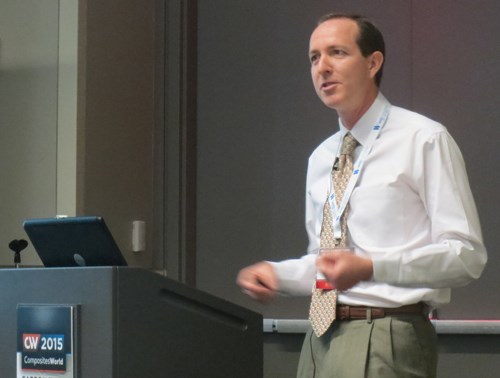For carbon fiber, the future certainly looks bright
CompositesWorld's annual Carbon Fiber conference last week included an upbeat outlook for the supply and demand of carbon fiber, with particularly strong growth expected in automotive, pressure vessels and energy development.

Chris Red, principal at Composites Forecasts and Consulting LLC, speaking during CompositesWorld's Carbon Fiber 2015 conference in Knoxville, TN, US.
Chris Red, principal at Composites Forecasts and Consulting LLC (Mesa, AZ, US), spoke last week about global carbon fiber supply and demand at CompositesWorld’s annual Carbon Fiber conference in Knoxville, TN, US. Chris’ carbon fiber presentations are highly respected and closely scrutinized as they typically provide a reliable assessment of how the market is behaving and trending. This year’s presentation was no exception.
The data here, culled from Chris’ presentation, speak for themselves, but there are some things you should notice.
| Market | 2015 | 2020 | 2024 | CAGR |
| Consumer/Recreational | 14,830 | 16,740 | 18,620 | 2.3% |
| Aerospace | 15,460 | 22,100 | 21,650 | 3.4% |
| Industrial | 52,800 | 118,490 | 178,920 | 13% |
| Total | 83,090 | 157,320 | 219,200 | 10.2% |
First, Chris divides the carbon fiber industry into three sectors: Aerospace, consumer/recreational and industrial (which includes automotive and energy). As has been the case for several years now, a vast majority (75%) of the world’s carbon fiber is consumed by the industrial sector, and going forward this is where most carbon fiber growth will occur.
| Year | Nameplate Capacity | Actual Output (est.) |
| 2015 | 143,595 | 93,171 |
| 2020 | 180,600 | 129,965 |
Second, although aerospace remains an important sector, with the Boeing 787, the Airbus A350 XWB and the F-35 Lightning II in production, and with the 777X wing program near production, there is no large aerocomposites program on the horizon to spur substantial carbon fiber manufacturing expansion. The next major programs — beyond the horizon — are replacements for the Airbus A320 and the Boeing 737. These are expected in the 2025-2030 timeframe and likely will be fabricated, at least in the wings, with carbon fiber. It remains to be seen whether carbon fiber will be chosen for the fuselage. The question is whether, in 10 years, composite fuselage fabrication processes will be sufficiently fast enough to meet the throughput requirements of a single-aisle aircraft program. Also unknown is if a single-aisle aircraft fuselage made with carbon fiber can efficiently withstand the runway rash and other impacts that a smaller (compared to the 787 and A350 XWB) plane must endure.
| Market | 2015 | 2020 | 2024 | CAGR |
| Commercial aircraft structures | 5,545 | 8,880 | 8,293 | 4.1% |
| Automotive | 10,056 | 23,456 | 47,011 | 13.7% |
| Pressure vessels | 5,364 | 19,519 | 39,955 | 22.24% |
| Wind energy | 15,000 | 30,000 | 32,643 | 8.1% |
Third, it appears that — finally — automotive is poised to become the carbon fiber juggernaut that we have been hoping it would be. Consensus at the conference was that automotive OEMs will likely take a material-agnostic, all-of-the-above approach to vehicle development, employing a mix of steel, aluminum and composites, applied as mechanical requirements demand and as cost allows.
Fourth, carbon fiber composite pressure vessels for storage and transport of compressed and liquefied natural gas in automotive and fleet applications is expected to drive substantial carbon fiber growth, particularly in Asia, South America and parts of Europe.
Carbon fiber in wind energy, you will notice, is forecast to grow steadily (8% CAGR), but at a rate slight less than the average for the entire carbon fiber industry (10.2% CAGR). This might be subject to change, however, given that the US Congress, on Dec. 16, passed a new budget plan that includes renewal of the renewable energy production tax credit (PTC) for five years. This represents an unprecedented window of PTC stability that might spur a new and substantial wave of wind turbine installations in the US.
Finally, you’ll notice that Chris expects, in about 2020, that carbon fiber demand will exceed supply. This likely will spur some level of carbon fiber manufacturing expansion in the 2018-2019 timeframe.
In short, there is much to like in these numbers as the carbon fiber growth trajectory seems to be on very solid footing for the foreseeable future.
Related Content
A new era for ceramic matrix composites
CMC is expanding, with new fiber production in Europe, faster processes and higher temperature materials enabling applications for industry, hypersonics and New Space.
Read MoreManufacturing the MFFD thermoplastic composite fuselage
Demonstrator’s upper, lower shells and assembly prove materials and new processes for lighter, cheaper and more sustainable high-rate future aircraft.
Read MorePlant tour: Albany Engineered Composites, Rochester, N.H., U.S.
Efficient, high-quality, well-controlled composites manufacturing at volume is the mantra for this 3D weaving specialist.
Read MoreNext-generation airship design enabled by modern composites
LTA Research’s proof-of-concept Pathfinder 1 modernizes a fully rigid airship design with a largely carbon fiber composite frame. R&D has already begun on higher volume, more automated manufacturing for the future.
Read MoreRead Next
CFRP planing head: 50% less mass, 1.5 times faster rotation
Novel, modular design minimizes weight for high-precision cutting tools with faster production speeds.
Read MoreVIDEO: High-rate composites production for aerospace
Westlake Epoxy’s process on display at CAMX 2024 reduces cycle time from hours to just 15 minutes.
Read More“Structured air” TPS safeguards composite structures
Powered by an 85% air/15% pure polyimide aerogel, Blueshift’s novel material system protects structures during transient thermal events from -200°C to beyond 2400°C for rockets, battery boxes and more.
Read More






















